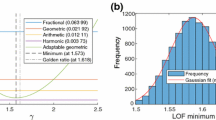Abstract
Except the alphabetic ordering authorship papers, the citations of multi-authored papers are allocated to the authors based on their contributions to the paper. For papers without clarification of contribution proportion, a function of author number and rank is presented to rightly determine the credit allocated proportion and allocated citations of each author. Our citation allocation scheme is between the equally fractional counting and the one using the inverse of author rank. It has a parameter to adjust the credit distribution among the different authors. The allocated citations can either be used alone to indicate one’s performance in a paper, or can be applied in the modification of h-index and g-index to represent the achievement of a scientist on the whole. The modified h-index and g-index of an author makes use of more papers in which he or she played important roles. Our method is suitable for the papers with wide range of author numbers.



Similar content being viewed by others
References
Alonso, S., Cabrerizo, F. J., Herrera-Viedma, E., & Herrera, F. (2009). h-Index: A review focused in its variants, computation and standardization for different scientific fields. Journal of Informetrics, 3, 273–289.
Bornmann, L., & Daniel, H. D. (2007). What do we know about the h index? Journal of the American Society for Information Science and Technology, 58, 1381–1385.
Boxenbaum, H., Pivinski, F., & Ruberg, S. J. (1987). Publication rates of pharmaceutical scientists: Application of the waring distribution. Drug Metabolism Reviews, 18(4), 553–571.
Chai, J. C., Hua, P. H., Rousseau, R., & Wan, J. K. (2008). The Adapted Pure h-Index. In H. Kretschmer & F. Havemann (Eds.), Proceedings of WIS 2008, Berlin.
Cole, J. R., & Cole, S. (1973). Social stratification in science. Chicago: The University Press.
Cronin, B. (2001). Hyperauthorship: A postmodern perversion or evidence of a structural shift in scholarly communication practices? Journal of the American Society for Information Science and Technology, 52, 558–569.
de Solla Price, D. J. (1981). Multiple Authorship. Science, 212, 986.
Egghe, L. (2006). Theory and practice of the g-index. Scientometrics, 69, 131–152.
Egghe, L. (2008). Mathematical theory of the h- and g-index in case of fractional counting of authorship. Journal of the American Society for Information Science and Technology, 59, 1608–1616.
Egghe, L., Rousseau, R., & Van Hooydonk, G. (2000). Methods for accrediting publications to authors or countries: Consequences for evaluation studies. Journal of the American Society for Information Science, 51, 145–157.
Fersht, A. (2009). The most influential journals: Impact Factor and Eigenfactor. PNAS, 106, 6883–6884.
Greene, M. (2007). The demise of the lone author. Nature, 450, 1165.
Gunsa, R., & Rousseau, R. (2009). Real and rational variants of the h-index and the g-index. Journal of Informetrics, 3, 64–71.
Hagen, N. T. (2008). Harmonic allocation of authorship credit: Source-level correction of bibliometric bias assures accurate publication and citation analysis. PLoS ONE, 3, e4021.
Hagen, N. T. (2010). Harmonic publication and citation counting: Sharing authorship credit equitably–not equally, geometricallyor arithmetically. Scientometrics, 84, 785–793.
Hirsch, J. E. (2005). An index to quantify an individual’s scientific research output. PNAS, 102, 16569–16572.
Hirsch, J. E. (2010). An index to quantify an individual’s scientific research output that takes into account the effect of multiple coauthorship. Scientometrics, 85, 741–754.
Hodge, S. E., & Greenberg, D. A. (1981). Publication credit. Science, 213(4511), 950.
Hu, X., Rousseau, R., & Chen, J. (2010). In those fields where multiple authorship is the rule, the h-index should be supplemented by role-based h-indices. Journal of Information Science, 36, 73–85.
Lindsey, D. (1980). Production and citation measures in the sociology of science: The problem of multiple authorship. Social Studies of Science, 10, 145–162.
Lukovits, I., & Vinkler, P. (1995). Correct credit distribution: A model for sharing credit among coauthors. Social Indicators Research, 36, 91–98.
Opthof, T., & Wilde, A. A. M. (2009). The Hirsch-index: A simple, new tool for the assessment of scientific output of individual scientists. Netherlands Heart Journal, Volume, 17, 145–154.
Schreiber, M. (2008a). To share the fame in a fair way, hm modifies h for multi-authored manuscripts. New Journal of Physics, 10, 040201.
Schreiber, M. (2008b). A modification of the h-index: The h(m)-index accounts for multi-authored manuscripts. Journal of Informetrics, 2, 211–216.
Schreiber, M. (2009). Fractionalized counting of publications for the g-Index. Journal of the American Society for Information Science, 60, 2145–2150.
Schreiber, M. (2010). A case study of the modified g index: Counting multi-author publications fractionally. Journal of Informetrics, 4, 636–643.
Sekercioglu, C. H. (2008). Quantifying coauthor contributions. Science, 322, 371.
Trueba, F. J., & Guerrero, H. (2004). A robust formula to credit authors for their publications. Scientometrics, 60, 181–204.
Van Hooydonk, G. (1997). Fractional counting of multiauthored publications: Consequences for the impact of authors. Journal of the American Society for Information Science, 48, 944–945.
Wan, J. K., Hua, P. H., & Rousseau, R. (2007). The pure h-index: Calculating an author’s h-index by taking co-authors into account. COLLNET Journal of Scientometrics and Information Management, 1, 1–5.
Zhang, C. T. (2009). A proposal for calculating weighted citations based on author rank. EMBO reports, 10, 416–417.
Acknowledgment
We are grateful to Wendy Powell in Valleyford, Washington USA for editing English of our manuscript.
Author information
Authors and Affiliations
Corresponding author
Rights and permissions
About this article
Cite this article
Liu, X.Z., Fang, H. Fairly sharing the credit of multi-authored papers and its application in the modification of h-index and g-index. Scientometrics 91, 37–49 (2012). https://doi.org/10.1007/s11192-011-0571-y
Received:
Published:
Issue Date:
DOI: https://doi.org/10.1007/s11192-011-0571-y




